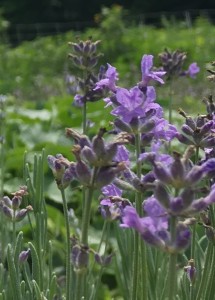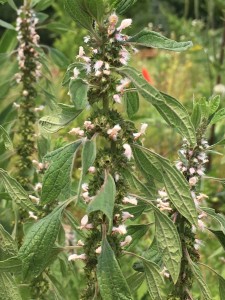Did you know that the mint family includes a variety of anti-anxiety herbs?
I make an herbal formula called Calm Focus, which is designed to help people do and feel exactly as the name suggests. I am not sure what is happening in the minds and hearts of people these days, but this particular formula has been flying off the shelves for a few months.
Herbal remedies are not always readily available for everyone, so I wanted to talk about anti-anxiety herbs that may be growing in and around your garden or backyard; and if not that, some are very likely sitting in spice bottles in your cupboard. I am talking about the mint family (Lamiaceae). Many mints are diversely medicinal, and the majority have beneficial effect on the mind. Whether restorative, calmative, stimulating, clarifying, pain-relieving, anxiety releasing or depression lifting, medicinal mints are remarkably effective, easily acquired, versatile in their uses, and usually very safe, even for babies.
Mints and the Physical Language of Plants
The physical language of plants helps us to predict and understand a plant’s medicinal virtues based on, among other things, its taste, aroma, color and notable features, and where it likes to grow.
Blue-Indigo-Violet spectrum as Color Indicator for the Mind: from a Language of Plants (Doctrine of Signatures) point of view, the blue-to-purple end of the color spectrum often indicates beneficial use for the nervous system and mental-emotional complex. Many anti-anxiety herbs have blue, lilac, indigo, magenta and/or purple coloration in their flowers or stems; and many mints have similarly colored flowers. I will talk about a few below
Spicy-Pungent for Clear Stimulation, Bitter for Grounded Focus: aroma and flavor are even more telling of a plant’s medicinal influence. Most of us are familiar with aromatic and flavorful mints, such as rosemary, sage, thyme, spearmint, and peppermint. The chemical constituents — usually volatile oils — that create these aromas and flavors are often the medicine as well. Sharper smelling mints can cut through mental fog and foster a vibrant clarity. But not all mints are aromatic, spicy, or pungent. Many are strongly bitter. Motherwort and skullcap come to mind; and it is these bitter constituents that exert the medicinal influence, a grounded, stable focus. Indeed, the aromas and flavors of spicy, aromatic, and bitter often indicates that a plant will have a positive influence on the mind and nervous system.
A Few Anti-Anxiety Herbs Growing at Clearpath Medicine Gardens
Wood Betony (Stachys betonica): “betonica” is a Celtic derivation of bew (meaning ‘head’) and ton (meaning ‘good’), wood betony being renowned for complaints emanating in the head. For centuries this herb was seen as a cure all for afflictions of both body and mind. The herb was believed to possess powerful magical properties, including warding off evil spirits, being used in exorcisms, ‘good against fearful visions’ and for ‘driving away devils and despair.’ Wood betony is restorative and calmative nervine for the mind, used for array of nervous tension complaints, especially if there is a stomach/digestion connection. I use it to treat anxiety, depression, lack of groundedness, hysteria, mental dullness, and weak will among other things.
Skullcap (Scutellaria lateriflora): also known as mad-dog skullcap, was regarded as such a powerful anti-anxiety herb that it was used to inhibit the madness brought on by rabies. This botter mint, often listed as a sedative, is better understood as a Central Nervous System (CNS) normalizer. It is also beneficial for the hypothalamus. For people who need to rest but do not, it seems like a sedative. I use skullcap alone and in formulas to relieve tension headaches, nervousness, restlessness, agitation, depression, irritability, for people easily frazzled or over-stimulated, for people who need to release constriction and clamping in body and mind.
Lavender (Lavendula spp.): This classically fragrant aromatic mint gently stimulates and strengthens nerve conductivity while also cooling and relieving irritation and nervous system heat. It is helpful for people with fragile or weak nervous systems prone to instability, nervous headaches and migraines, anxiety and depression, emotional flatness and repression, poor memory, poor cerebral circulation.
Purple Bee Balm (Monarda fustulosa): also called purple bergamot, this pungent plant, reminiscent of oregano, is an underrated nervous system tonic of significance. It strengthens and tones the nervous system and brain; both head clearing and relaxing. Useful in mind formulas addressing anxiety, runaway brain, foggy brain as well as sleep disturbances due to anxiety; and it is also an excellent restorative tonic for a debilitated nervous system.
Motherwort (Leonurus cardiaca): the flowers of this striking, non-aromatic, bitter mint are at the extreme end of the violet spectrum, ranging from white and light pink to a pale lilac. This powerful medicine is renowned as female reproductive herb, but its virtues extend beyond that, and I use it as frequently as any herb my repertoire in formulas addressing anxiety and irritability, especially
when the anxiety penetrates into other systems, including the heart and cardiovascular system, female reproductive system, and digestive system and liver-gallbladder. It is also a specific remedy for addressing anxiety caused by a hyperactive thyroid.
I haven’t even come close to expounding all the merits and virtues of these plants. Although famed as anti-anxiety herbs, their influence is far-reaching and pervades most organ-systems. You can learn about a large number of mints and other herbs in great depth in any of the Materia Medica classes taught throughout the year. You can also visit and enjoy the company of these plants every Monday at Clearpath Medicine Gardens volunteer work day. The first Monday session goes from 9:30am – 12:30pm. We then break for lunch and start up again around 2pm.




I have used this formula and I really liked it (I think it did help me). How can I buy another bottle of it? Please let me know.